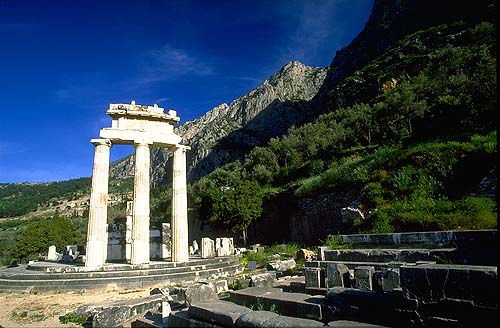Delphi; Here Socrates was declared as the wisest of men. The most uncompromised philosophers respected Delphi. Alexander the great was declared invincible in Delphi too.
Delphi; the most celebrated place in the ancient world. The word Oracle of Delphi has three meanings: 1. Prophecy, 2. Pithia (priestess), 3. the oracle itself.
History
This sacred precinct at Delphi was dedicated either to Athena Pronoia (Athena of Foresight) or Athena Pronaia (Athena before the Temple). The former epithet seems to echo the function of the Oracle of Apollo at Delphi, while the latter could refer to the sanctuary’s position below (and on the way to) the great Temple of Apollo.
This site has been revered since Mycenaean times (c.15th century BC. Clay figurines of women and fine sculptures from this period can be admired in the Delphi Museum.
The first Temple of Athena was built here in the 7th century BC and rebuilt at the beginning of the 5th century BC. In the early 4th century BC (c.360 BC), the New Temple of Athena was built in another part of the precinct, along with the mysterious Tholos. The nearby gymnasium was built in this period as well.
What to See
Overlooking a beautiful valley carpeted with olive trees, the sacred precinct dedicated to Athena is roughly rectangular in shape, with the entrance at the east end. Pilgrims entered the sanctuary through a monumental gateway, the huge lintel of which now lies on the ground.
Most of the sanctuary’s structures have been reduced to foundations and fallen fragments, including two successive temples of Athena. The oldest part of the sanctuary is the eastern part, where the remains of a Mycenaean settlement were unearthed.
Temple of Athena
Here stood the Old Temple of Athena, built in the early 5th century BC on the foundations of a 7th-century structure. Made of tufa, it was a Doric peripteral hexastyle building. The temple was badly damaged in 480 BC by a rock slide and finished off by an earthquake in 373 BC. Another landslide in 1905 demolished all but three columns.
The central area of the sanctuary is occupied by three buildings: a Doric treasury (490-60 BC) made of marble on a limestone foundation; the fine Aeolian Treasury of Massalia (c.530) of Parian marble; and the Tholos.
Tholos
The Tholos, a Pentelic marble rotunda from the early 4th century BC, is of unknown purpose and dedication but may have sheltered an important statue. The design has been attributed by some to Theodorus of Phocaia, who built the tholos at the Asclepion of Epidaurus. The Delphi tholos consists of a round platform with three steps supported by a circular peristyle of 20 slender Doric columns. The interior, paved and decorated with Corinthian half-columns, was entered from the south. Three columns of the Tholos with their entablature were re-erected in 1938 and the cornice and metopes were replicated based on surviving fragments. Surrounded by a field of architectural fragments against a mountain backdrop, it is perhaps the most picturesque sight in Delphi.
The west end of the precinct is occupied by the New Temple of Athena, built around 360 BC and reduced to foundations. It was a prostyle temple with a portico of six Doric columns.
Northwest of the sanctuary is the ruins of a gymnasium built in the 4th century BC and rebuilt by the Romans.

